![]()
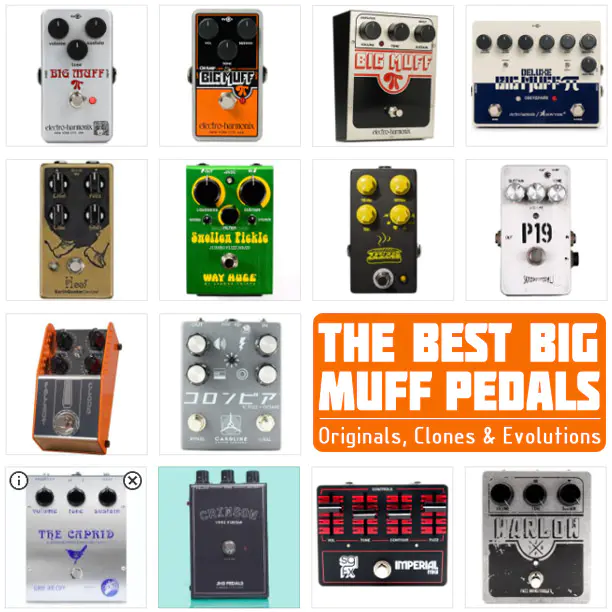
Updated on August 05, 2022
Welcome to our guide to the best Big Muff-style fuzz pedals!
While the Tone Bender and Fuzz Face pedals are often used by players in search of a vintage tone, the Electro Harmonix Big Muff Pi has truly found a home on the pedalboards of a younger generation of guitarists and bassists.
The Big Muff, and its innumerable offspring, are the most popular type of fuzz on the planet. Equally beloved by indie rockers and metalheads, you would be hard-pressed to find a modern band that hasn’t used a Muff at some point. There are too many artists to name, but the Muff can be heard on iconic recordings by artists such as Pink Floyd, Santana, King Crimson, the Smashing Pumpkins, Sonic Youth, Dinosaur Jr., The White Stripes, My Bloody Valentine, The Black Keys, Bon Iver, Nine Inch Nails, Boris, and many, many more.
The Sound of the Big Muff
The sound of the Muff is smooth, with an articulate attack. Mike Matthews, the founder of Electro-Harmonix, described it as violin-like. The gain knob is labeled “Sustain,” because the Muff will sustain your notes for as long as you want it to. The Muff has a unique EQ section that separates the signal into a high pass and a low pass filter, which are blended back together with the tone knob. The space between the two filters creates the famous “mid scoop.” This is part of the reason the Muff sounds mellow, or “muffled.” The mid scoop is notorious for making guitars disappear in a live mix, but it also makes the Muff perfect for stacking with more mid-forward overdrives, like a certain green box for example.
Click here for a Brief History of the Big Muff Pi—
We are certainly living in the golden age of Big Muffs. The circuit is more popular than ever and the amount of Muff options on the market is overwhelming. Here is a guide to help you choose.
Most Popular and Iconic EHX Big Muffs Available Now
As Electro-Harmonix’s flagship product, the Big Muff is always available in several varieties. Whether it be nano, deluxe, or vintage reissue, EHX has you covered no matter which Muff you’re after. Here’s a list of the most iconic Big Muffs currently available, the NYC builder helped us compile this list!
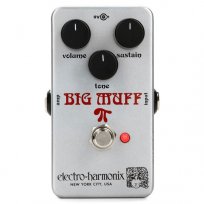
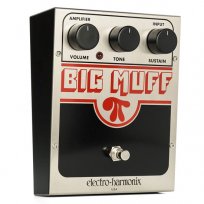

The most coveted of all the Muffs, the early 70s Ram’s Head was used by David Gilmour for his epic, singing lead tone. The Ram’s head is articulate and very loud, with a bit of vintage “spittiness.”
The Russian Muffs are coveted by bassists and heavy players for their big, boosted low end. They are very smooth and have slightly less gain than the other Muffs. If you’re worried that a vintage Russian has some special unobtanium in it, don’t be. These circuits are identical to the 90s versions.
The current iteration of the classic Big Muff is affordable, iconic, and the best-selling Muff of all time. The sound is very smooth and versatile, lending itself equally well to garage rock, punk, and metal. Everyone should own one!
When EHX started building Muffs in the late 60s, the circuit was not standardized and any two Triangle Muffs could sound different. EHX referenced two vintage models to create this reissue, and successfully captured the bite and gated unpredictability of these early units.
EHX brought back the 70s IC Muff and colored it orange in tribute to the Smashing Pumpkins. This pedal created the crushing distortion on songs like “Cherub Rock” and “Geek USA.” The Op-Amp Muff comes with a switch that bypasses the tone section for massive volume and a different EQ curve.
The Nano takes the NYC model and shrinks it down to pedalboard-friendly size. Does it sound any different? Maybe. But not nearly enough to make a meaningful difference. Adjusting the Nano’s tone and sustain will get you the same range of sounds as its big brother.
This variant adds a “wicker” control that bypasses high-end roll-off capacitors, resulting in a spitty, raspier sound. The tone bypass switch from the op-amp version is also brought back for a gain boost and altered midrange response.
EHX’s response to boutique builders expanding on their circuit is the highly tweakable Deluxe Big Muff. The 90s Russian Muff is the basis, but with a noise gate, parametric EQ, and bass boost switch, this pedal is a tonal powerhouse. The real selling point is the mid boost footswitch, which allows you to cut through any mix without the help of another pedal.
This variant includes all the same deluxe features as the Sovtek version but uses the NYC muff as its circuit blueprint. It just comes down to which base model you prefer.
The new Nano Metal Muff is a different beast from most Muff circuits, optimized for heavy genres with intense distortion that can range from tight to huge and sludgy. It has a three-band tone control for maximum versatility and a noise gate to eliminate feedback and hum.
—
The Best Big Muff Clones
The complicated history of Electro-Harmonix means that many Muff revisions have been discontinued or tweaked over time. There are certain circuits that pedal enthusiasts just crave, and for that reason, boutique builders have stepped up to the plate to recreate some of the most famous Muffs from the pedal’s long history.
Matthew Holl of Wren and Cuff is a Muff expert, and the Caprid is his tribute to the coveted early 70s Ram’s Head Muffs. He referenced four versions of the circuit and combined what he believed to be the best parts of each to create this replica. Even the circuit board and the enclosures are the exact same design as the classic versions. It also happens to look just incredible.
This entry into the JHS Legends of Fuzz series is a replica of one of Josh Scott’s own vintage Red Army Overdrives from the early 90s. Despite being called an overdrive, this was the first Muff Mike Matthews made in Russia. Like all of the fuzzes in the lineup, the crimson has a special “JHS Mode” button which in this case activates a mid frequency boost.
While not actually modeled after a Muff, the Imperial is based on a rare Muff clone from the 70s, the JEN Jumbo Fuzz. Both the original and this remake feature sliders instead of knobs, and a germanium noise gate to control feedback. Like many pedals on this list, the Imperial features a Mids contour control for achieving a less scooped sound.
German boutique JPTR FX make this high gain Op-amp Muff perfect for a low-end-heavy ’90s grunge and alt-rock. Using high-grade IC chips and germanium clipping diodes, the Warlow comes in an appropriately large enclosure for its equally huge tones.
The current NYC Big Muff is different from the 2000s circuit designed by Fran Blanche, extensively used by Jack White on the early White Stripes albums. Enter Alec from MAE, who created the Black Math as a tribute to that Detroit garage sound. The Black Math adds a pre-gain Boost control for even more pummeling distortion, and a blowout switch – effectively an auto-Jack White mode that makes your pick attack brutally compress and shred every note you hit.
Matt Pasquerella of Stomp Under Foot is a Muff expert and historian. Using the same Russian KT3102 transistors as the mid 90s “Civil War” Muffs, his Civil Unrest also includes a mids control which is very useful for live situations. Check out his website for all of his spot on versions of almost every Muff version ever made!
The Red Muck keeps it classic with the three-knob layout but combines the most beloved aspects of the Green Russian and the Ram’s Head designs into one pedal. You get the clarity and articulation of the Ram’s Head along with the heavy bass and smoothness of the Russian in one compact pedal. MK2 adds additional clipping and boosting options.
There are quite a few Ram’s Heads on the market. But this is known as one of the best, played by Lee Harris, the guitarist in Nick Mason’s Saucerful of Secrets. Hand-wired with through-hole parts, the Pig Hoof is also lauded by the experts at gillmourish.com. The Pig Hoof will get you that magical tone heard on Animals and The Wall.
It is a bit harder to find Triangle Muff clones, and this one is a loving interpretation of the late-60s classic. With more mids than a Ram’s Head, the Tri-Pi will cut through a mix well, and the top jacks allow you to save precious pedalboard real estate.
Another hand-wired, lovingly made clone, the Vick Audio Violet Ram’s Head has the high gain sustain of the early 70s muffs with the top end smoothness of some Russian muffs. A useful three-position mids switch is added for scooped, flat, and boosted response.
—
The Best Big Muff Evolutions
It is thanks in no small part to cult modern builders that the Muff has garnered such a following in underground and DIY scenes. Here are takes on the circuit that add modern features or tweaks to evolve the Muff blueprint into something distinct.
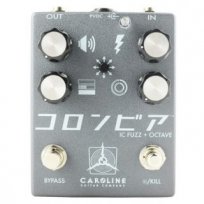
The pedal that put Earthquaker on the map. Jamie Stillman’s first pedal is loosely based on a specific green Russian Muff belonging to his friend Dan Auerbach of the Black Keys. The hoof is a hybrid germanium/silicon design with a huge low end but enough presence to sound articulate and defined. The ever-useful Shift knob will scoop or boost your midrange. See also the Hoof Reaper with octave-up effect.
Jeorge Tripps’ flagship fuzz uses a Muff as its blueprint but comes with more tone-shaping possibilities. Instead of the standard Muff tone control, there is a high-end roll-off filter. The Scoop switch can add in some midrange punch while the Crunch switch allows switching between a more compressed or open sound. See also the Russian Pickle for a Green Russian-inspired Way Huge design.
This pedal is one of Josh Scott’s greatest conceits: 6 beloved Muffs in one compact enclosure. Selectable on a dial are the V1 Triangle, V2 Ram’s Head, V3 IC Muff, V7 Civil War, V8 Russian, and a special JHS Muff with more midrange and less compression. Using all-analog circuitry, these aren’t just approximations of the original circuits, they are identical.
One of the most beloved Muff clone builders, Skreddy has been building boutique effects since the early 2000s. The P19 is designer Marc Ahlfs’ take on David Gilmour’s ultimate recorded fuzz tone, as heard on The Wall. Not exactly a Ram’s Head, the P19 takes into account the mic placement, compression, and other production choices that go into laying down a guitar track. See also the Rust Rod, General Pig, and BC239, other Skreddy takes on the Ram’s Head blueprint.
Adrian Thorpe set out to make a Triangle-style Muff that could be gigged for decades and matched with any guitar, amp, and pickup combination. The Fallout Cloud is the result, a huge sounding fuzz built with premium components. The separate treble and bass controls allow for more in-depth tonal shaping than a traditional Muff.
A criticism of the Muff is that it dominates your tone, nullifying all the work you put into choosing your amp, pedals, and guitar. The Pharaoh and Son of Pharaoh pedals seek to fix that issue by being extremely versatile. It can be a light overdrive all the way to an intense fuzz that cleans up with your guitar volume. With two tone controls, a hi / lo input switch for increased headroom, and switchable germanium/silicon clipping diodes, this pedal can be the last fuzz you ever buy.
Another highly versatile od/distortion/fuzz, the Shigeharu is capable of everything from punchy overdrive to full on IC Muff destruction. Holding down the momentary Havoc foot switch engages a spitty upper octave for maximum chaos.
- Wren and Cuff BM-20 Ultra (formerly the De La Riva)
For Muff nerds only. The BM-20 comes with dip switches on the front that allow you to change the Muff circuit at 20 different points. Combined with the tone bypass option and silicon and germanium transistor switching, you have over 4 million unique settings available.
An original Muff-style fuzz circuit based on a silicon transistor design. The classic three knobs for Level, Gain and Tone and expanded by a three-way toggle switch that offers different bass settings, a useful feature for switching between single-coil and humbucker guitars or beefing up your tone. It can also produce a gated-fuzz response in the “lightning” setting (right position).
A more malleable take on the fuzz circuit included in the company’s Dark Side multi-effect, this is a rather simple, 3-knob + 1-toggle quad op-amp Muff-style fuzz with a massive low end. A filter section lets you pick among three filter shapes through the toggle switch in the middle of the case: Flat, Full, and Scooped.
Berlin-based KMA’s Dead Stag lets you tailor your fuzz sound to any situation. An active bass and treble eq with 15db of cut and boost is paired with a parametric mid eq for scooping or pushing through a mix. A high/low gain switch cranks up the distortion to extreme levels and a smooth/sharp switch gives you a high mids boost for added clarity.
A multi-mode muff clone simulating three different Russian fuzz circuits (Black, Green and Civil War) through a 3-way toggle, while also offering a fourth sound achievable by entirely bypassing the “Version” circuit. A second channel stacks an overdrive circuit on top of the muff, with a slight mids bump (tweakable via internal trim pots), for extra punch.
Intentionally simple, this muff evolution intends to provide the player with plenty of tonal options without an excessive number of controls. Inspired by the Ram’s Head Muff, the T4 is an attempt to “perfect” that sound with better components, a more present mid-range, and a sweeter-sounding tone control. The output volume is also increased to push your amp to the edge of breakup.
This one-knob wonder is for players who know exactly what sound they are going for. There is a fixed gain and no tone stack to get in the way of the huge sound. With more mids than your standard Muff, this pedal could be always left on as it also cleans up to a crunchy distortion with the volume knob on your guitar.
A super-tweakable Muff-style fuzz with parametric footswitchable mids and three voices: Tight: modern Big Muff sound with tight lows, focused mids and a crisp top end; Vintage: Classy Muff Sound, low- to mid-gain distortion, balanced frequency response; Heavy: full blast Big Muff sound with massive low end and plenty of gain. Dry signal can be reintroduced pre or post gain.
A very high end, gorgeous-looking PTP Civil War Muff-style box that’s hand-made in the UK and sells for over $435 USD (£329.00) – plus shipping. It features the three classic knobs for Gain, Volume and Tone, and two toggle switches delivering mid-boost and low cut. Together with top-notch components, sound and circuitry, you also get a unique case, because the final finish may differ very slightly from one pedal to the next.
Muff Shootout Videos
All Electro-Harmonix Big Muff Pedals Compared – Fuzz Shootout
JHS’s Big Muff Shootout: Vintage V.S. Reissue
2020 EHX BIG MUFF PI SHOOTOUT: Nano, Green Russian, OpAmp, Triangle, Ram’s Head & Nano Bass Big Muff
5 EHX Nano Big Muff Pedals (Nano, Triangle, Green Russian, OpAmp, Nano Bass Big Muff)
Battle of the budget vs. EHX OpAmp & Caprid. #AffordaBoard















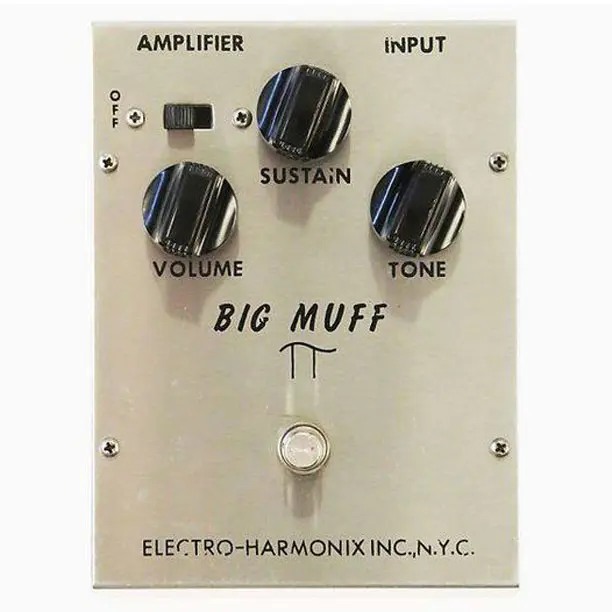
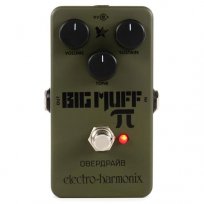
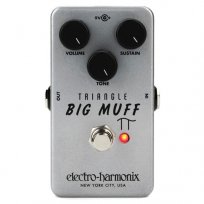
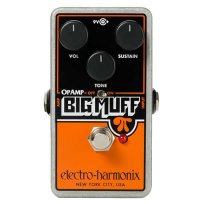
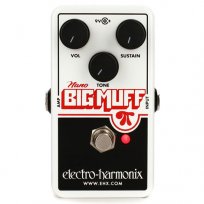
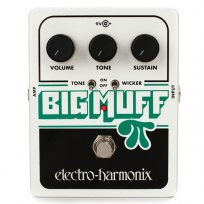
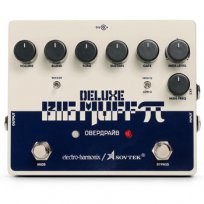

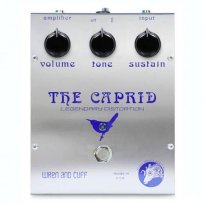
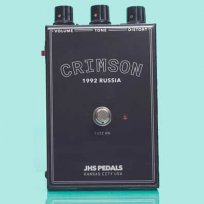
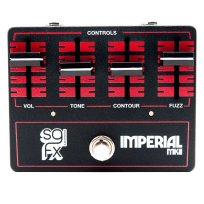
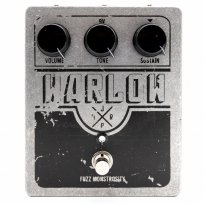
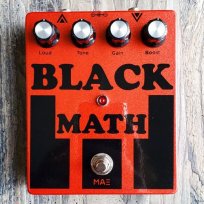
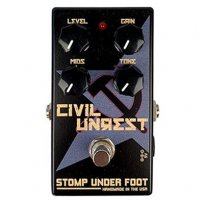
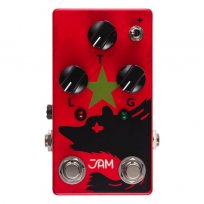
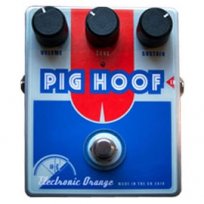
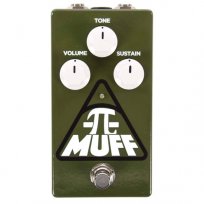
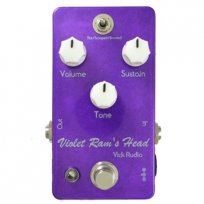

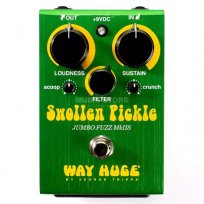
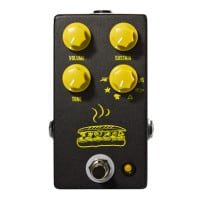
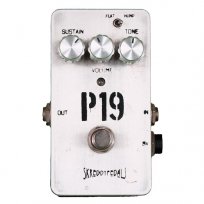
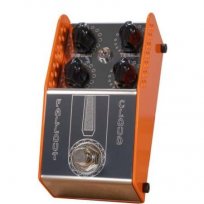
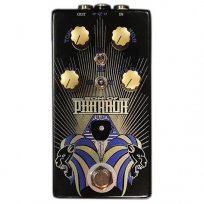
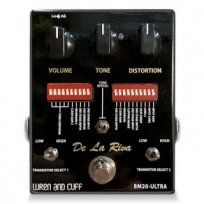
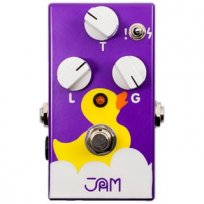
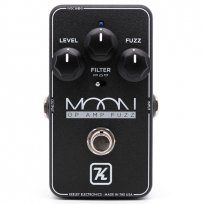
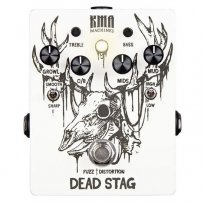
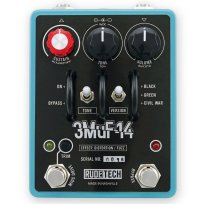
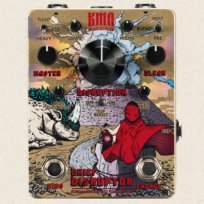
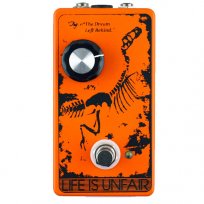
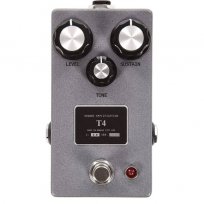

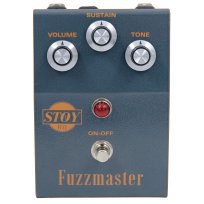








3 comments
Dane M says:
Jun 9, 2021
I feel like the Ibanez OD850 should have made this article.
Reg Hunt says:
Jun 10, 2021
Interesting, I used to have a Swollen Pickle, didn’t seem Muffy to me. Maybe the circuit is more similar than I realized.
Reg Hunt says:
Jun 10, 2021
I always considered the Big Muff as a huge influence on Robert Fripp’s sound, back in the day, especially for Frippertronics.
It’s often said that Fripp used the Burns Buzzaround, and maybe at some point he did (cuz he mentioned it in an interview once). But around 1972, his pedalboards were built with Guild branded triangle Big Muffs. That’s where that sustained sound came from. And that’s what he used for Frippertronics.